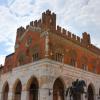Medieval villages perched on hills and preserved intact over the centuries, labyrinths of bamboo canes surrounded by cultural and exhibition areas, royal apartments and world famous Romanesque architectural masterpieces: Autogrill's new Fiorenzuola d'Arda Bistrot is located halfway between Parma and Piacenza, a few kilometers from some of the most beautiful cities of art and Italian tourist attractions. Here are some tourist destinations that you can visit during your next trip.
The majestic architecture of the Cathedral and the Palazzo Comunale in Piacenza
Founded by the Romans, Piacenza boasts a rich architectural heritage accumulated since the Middle Ages. An important example of Romanesque architecture in Italy, the Cathedral of Piacenza is home to the first sculpture by the medieval artist Niccolò, one of the most important master sculptors of that time. The Palazzo Comunale, known as Il Gotico (The Gothic) because of its architectural style, and the Palazzo Farnese, imposing residence of the Ducal family and now home to the city's museums, stand out as examples of civil architecture.
The impressive fortress of Castell’Arquato
The town, perched on a hill, is home to a well preserved medieval village. Among the most important historic buildings are the Palazzo del Podesta and the Rocca Viscontea, an imposing fortress which dominates the top of the hill and was for centuries the seat of military garrisons. Today the fort is a museum dedicated to life in the Middle Ages.
The medieval village of Vigoleno
With an orange flag certification from the Italian Touring Club, Vigoleno is a rare example of a fortified medieval village which has survived intact to this day. Enclosed by a ring of crenellated walls, with a panoramic wall-walk (chemin de ronde) that is still accessible today, it is home to museum rooms inside the keep tower where historical and photographic documentation is exhibited.
The antique bridge of Bobbio with its curious irregular shape
The Ponte Gobbo (Hunchback Bridge), so-called because of its irregular shape resulting from the differing height of the spans, crosses the river Trebbia near Bobbio. It is believed to date back to Roman times, although it has undergone various interventions and restoration over the centuries; In the Middle Ages several legends linked the construction of the bridge to a clash between the Devil and Saint Colombanus.
The largest maze in the world in Fontanellato
The largest maze in the world is found in Fontanellato, star-shaped and formed by hundreds of thousands of bamboo plants covering an area of seven hectares. There are cultural and exhibition spaces in the buildings situated inside and outside the maze. Opened to the public in 2015, the Labirinto della Masone was built by the publisher Franco Maria Ricci, from Parma, who was inspired by the famous Argentine writer, Jorge Luis Borges.
The combination of Roman and Gothic architecture in Parma
Of Etruscan or Celtic origin, Parma is rich in monuments built over the course of its history, churches, palaces and theaters, because of the city's important lyrical tradition. The Duomo, an exemplary example of Romanesque architecture which houses the Deposition of the Cross by Benedetto Antelami and, in the cupola, Renaissance frescoes by Correggio, and the adjacent Baptistery by Antelami which combines Romanesque and Gothic architecture, both occupy a prominent place among the most famous monuments of Parma.
The unusual construction of Villa Pallavicino in Busseto
This Renaissance villa located in Busseto, for centuries the home of the family of the same name, is assumed to have been designed by Bramante or Vignola. Built on an unusual grid plan, it is located at the center of a square-shaped artificial island, entirely surrounded by a fish pond. In the Baroque era decorations were added to the facade featuring cornices and rococo plasterwork and the adjacent Palazzo delle Scuderie (Stable Palace) was built. Today the Villa houses the Museo Nazionale Giuseppe Verdi, who was a native of the town.
The apartments of the Royal palace of Colorno
This monumental residence, which also boasts an extensive French garden, was built in its present form in the early eighteenth century and has hosted many noble families, including that of Marie Louise of Austria. Today it houses temporary exhibitions and cultural events, and some parts of it are upkept for viewing, including the Ducal Apartments and the neoclassical Chapel of San Liborio.
The facade of the Duomo di Fidenza
The Romanesque architectural complex of the San Donnino Cathedral, the Duomo Di Fidenza, is best known for the rich sculptural decoration of its facade, made up of numerous bas-reliefs and some statues by the aforementioned Antelami and his school, that portray, with didactic intent, religious, historical and allegorical subjects.
The thermal waters of Salsomaggiore
Already known in antiquity, the mineral rich thermal waters of Salsomaggiore were recognized as having healing properties in the nineteenth century, giving rise to the creation of various thermal baths, which today are still up and running thanks to recent renovation and expansion.
Our journey in the surroundings of Fiorenzuola d'Arda concludes here, but we invite you to discover the many other cultural marvels in the area and stay tuned: the journey on the discovery of Bistrot Fiorenzuola d'Arda's territory continues.
Located in the upper Val Taro on the Parma Apennines are the Riserva Naturale Regionale (Regional Natural Reserve) and WWF Oasis of Ghirardi, which extends over six hundred hectares of woods and meadows and is home to numerous plant and animal species, including the wolf.





